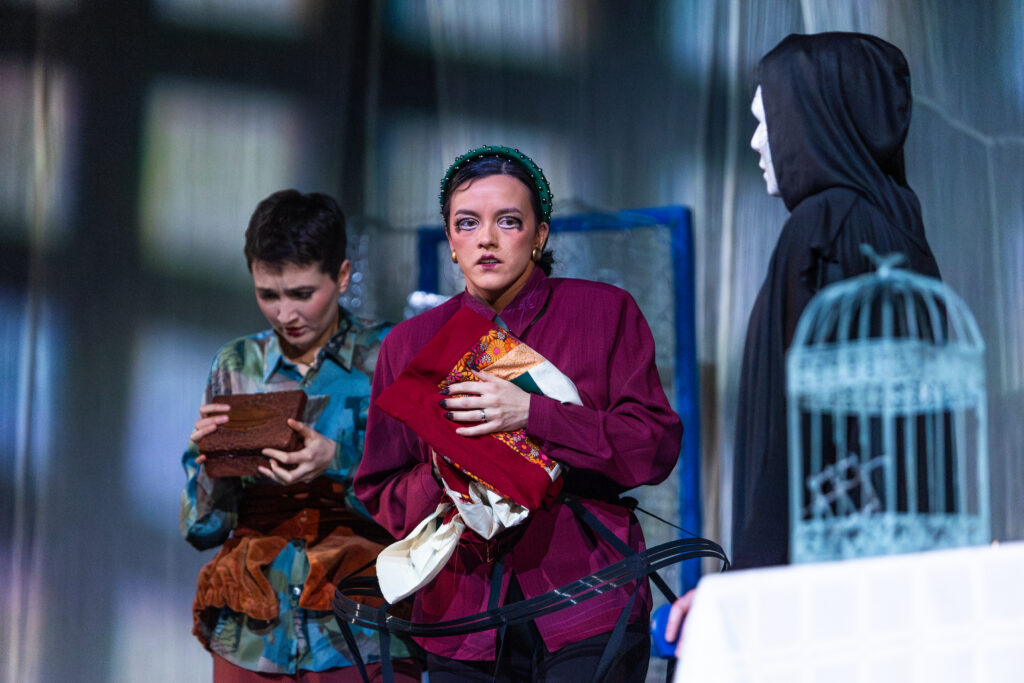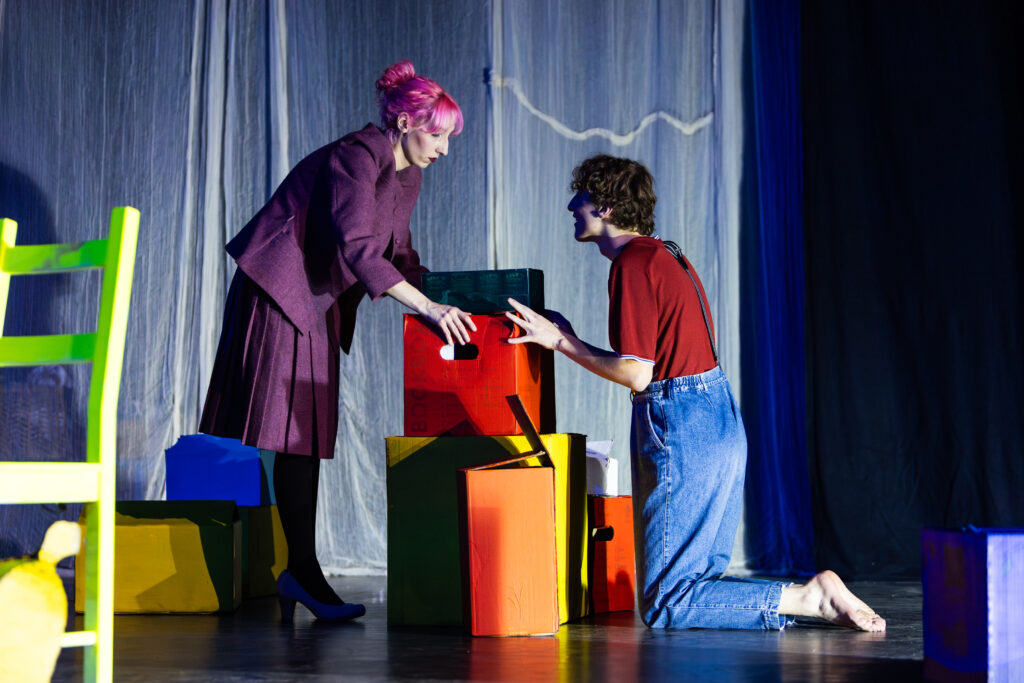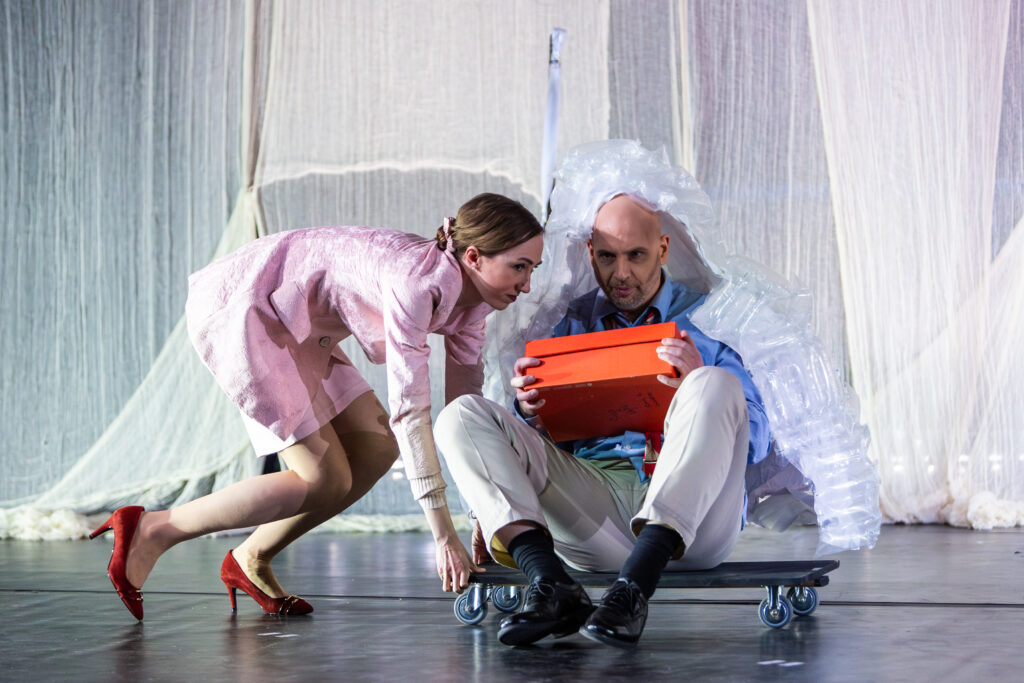By Nadine Baghirova
On 22 January, the University of Hamburg’s Audi Max auditorium hosted a series of theatrical performances, featuring two plays. As the audience was transported to the early 20th-century England, they became immersed in the lives of traditional wives. The students were eager to immerse themselves in the roles of traditional wives and the mystery that awaited them. The second play, set in the late 20th century, explores the tumultuous dynamics of a family grappling with the American Dream.
The first play, titled „Trifles“, is a murder mystery set in an abandoned farmhouse, where the body of John Wright, the husband of Minnie Wright, is discovered under enigmatic circumstances. As the narrative progresses, two detectives initiate an investigation, while Mrs. Hale and Mrs. Peters meticulously examine the domestic sphere, unveiling nuanced insights into the couple’s way of life. Through their meticulous analysis, the detectives delve deeper, unveiling Mrs. Wright’s emotional struggles and the intricacies of power dynamics within the marriage.The play illuminates the interplay of gender roles, justice, and the nascent feminist movement. It raises awareness of ongoing femicides and provokes thought about morality and truth.

The second play, The American Dream, presents a family dynamic and societal expectations of the 1950s.The play revolves around a shallow and dysfunctional family consisting of Mummy, Daddy and Grandma. The family awaits Mrs Barker, a professional woman who played a significant role in the past, as revealed later. As the narrative progresses, the characters engage in absurd and unsettling interactions, exposing their superficial values. Moreover, the arrival of the „perfect“ young man brings the family a new sense of purpose, highlighting the emptiness and contradictions of the so-called “American Dream.”
In the first play, the actors delivered a performance that kept the audience’s attention. The actors seamlessly embodied the roles of oppressed housewives, allowing the audience to empathise with the characters‘ inner turmoil. This profoundly impacted the viewer, prompting introspection regarding their own moral compass and potential responses to similar circumstances. The actress’s portrayal of Mrs. Hale and Mrs. Peters was poignant, evoking a profound sense of emotional depth and authentic vulnerability, characteristic of the oppressed traditional wife.

Turning to the second play, the cast demonstrated a commendable level of energy and sarcasm, eliciting intermittent laughter from the audience. As the narrative unfolded, the audience came to discern the profound implications of the American dream and its apparent superficiality, a feat facilitated by the adept performance of the actors. Mommy’s performance was particularly noteworthy, as she demonstrated an ability to convey the full range of her character’s emotions through her facial expressions.
The set for the first play was a meticulous recreation of a 20th-century household, replete with period-accurate costumes, including those that were tight-fitting for the women. The juxtaposition of real-life props and the fleeting glimpses of projected snippets, signifying a flashback, infused the production with a sense of dynamism.
The set for the second play featured an intriguing arrangement of boxes, which added a layer of complexity to the mise-en-scène. The television, which offered insight into the era, with its contemporary resonance, was a notable aspect. The props, including the child, were meticulously crafted, showcasing the ingenuity of the university students who designed and constructed the set. Moreover, the message of the play was evidently articulated, ultimately encouraging the audience to re-evaluate the significance attributed by society to that which is deemed unimportant, thereby demonstrating that that which is often overlooked may in fact contain the key to truth. The critique of gender inequality and oppression renders this play a timeless commentary on the silencing of women’s voices, a point that was subsequently emphasized through the presentation of a statistical analysis. Lines like “It takes two to make a child—not raise one” stood out. The play’s exploration of the American dream is noteworthy for its relevance to contemporary societal issues, particularly the pursuit of material success and perfection that often results more profound emotional connections. The actors conveyed the emptiness and the obsession of success with remarkable skill, facilitating the transfer of this obsession to the contemporary world of consumer culture and the pressure to achieve an idealised version of success, which ultimately leads to emotional emptiness and disillusionment.

However, I have to add as critique, that as a pupil who had endured an exhausting day at school, the prospect of sitting through a four-hour play in the evening did not appeal to me. This resulted in a considerable challenge in maintaining concentration during the performance. However, I have no significant critique regarding the actors‘ abilities or stage presence.
In conclusion, both plays offered unique experiences that I would recommend. It is imperative to raise awareness of these subjects, especially among students, who represent the future of this world. The two plays combined to provide a well-rounded theatrical experience, offering a diverse range of acting styles. It might not be for everyone, but if you like satirical and thought-provoking stories, you’ll find “The American Dream” to be both entertaining and eye-opening.
Photos by Sarah Naumann


Schreibe einen Kommentar